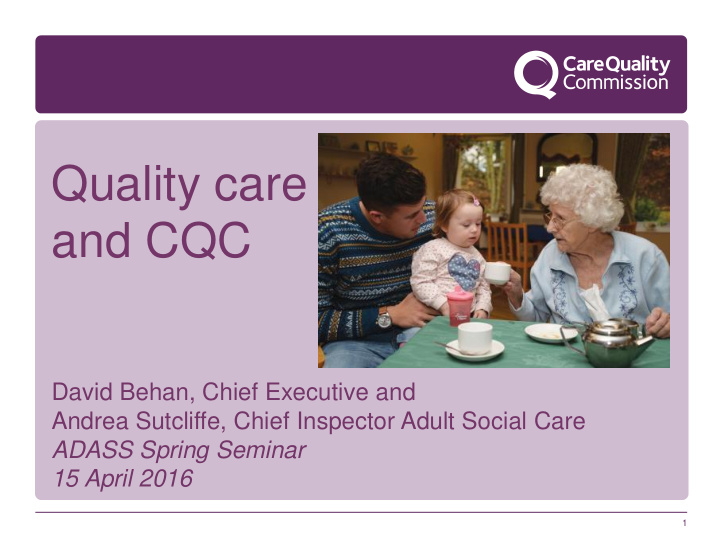



Quality care and CQC David Behan, Chief Executive and Andrea Sutcliffe, Chief Inspector Adult Social Care ADASS Spring Seminar 15 April 2016 1
Current overall ratings Source: CQC ratings data at 6 April 2016 2
Overall ratings key question Source: CQC ratings data at 6 April 2016 Note: Figures in chart are percentages 3
Overall ratings by service type Community social care (744) Domiciliary care agencies (2,755) Residential homes (7,546) Nursing homes (3,278) Source: CQC ratings data at 6 April 2016 4
Overall ratings by size of care home Source: CQC ratings data at 6 April 2016 Note: Figures in chart are percentages 5
Overall ratings by size of DCA Source: CQC ratings data at 6 April 2016 6
Outstanding characteristics • People are at the centre and staff want to give them a life not just a service • Good leadership extends beyond the manager and those values are cascaded to inspire staff • Open culture – people who use services/ staff/ relatives shared views and issues • Strong links with local community • 75% have registered manager in post consistently • A can do, will do attitude – staff dedication • Safe care actively promoted – effective oversight of care and staff communication 7
Market oversight Aims Spot if a ‘Southern Cross’ could happen again 1. 2. Protect people in vulnerable circumstances Monitor finances of ‘difficult to replace’ providers 3. 4. Provide early warning to local authorities and assist in coordinating system response if failure occurs MO does not : 1. Protect providers from failure 2. Pre-empt failure through disclosure of information Mechanism – analysis of quarterly financial and quality information to provide the necessary notification to LA(s) so they can invoke contingency planning arrangements 50 providers in the scheme 8
Market oversight key updates Market Oversight is operational but providers can and will exit the market without triggering an LA notification Market Trends – domiciliary care agencies increasing, residential homes reducing since 2010. Nursing homes and beds increased until September 2015 now reducing Total residential and nursing beds decreased in the 12 months to September 2015 for first time since 2010 Financial Trends – since 2006/07 profitability has decreased by almost 20%. Providers leaving where not profitable and exiting entire markets in some places. 9
Reflections – on quality Great care despite the stresses and strains Dedicated and committed staff delivering great care – sometimes despite the system not supported by it Variability is rife Services are improving on re-inspection – is that sustainable? Finance an ongoing pressure and resilience in sector increasingly fragile Small operators at risk and not included in market oversight Supply is reducing while demand is increasing Economies of scale are reducing the quality of care 10
Reflections – CQC and ADASS We have common purpose in ensuring good quality, person-centred care for people using services You are under increasing financial pressure, but we will not compromise on our assessment of quality We need to work better together: to share information t o act on each other’s findings to encourage improvement to sustain market stability There is good practice nationally and locally but not universal One example – care home closures…. 11
Handling urgent and unplanned closures Statutory bodies ( LA, CCG, CQC ) and providers must work in partnership to improve closure and crisis move process and lessen impact on people 1. Prevention is better than cure 2. If quality failure happens, all parties need to know what to do and to work effectively together 3. The needs of people using services must be at the heart of everything we do 4. Communication is key Plan to publish guidance in June 2016 12
Why a new strategy? A changing environment Use and delivery of regulated services is changing CQC must deliver its purpose with fewer resources Adapt and improve We want to become more efficient and effective to stay relevant and sustainable for the future The public, and organisations that deliver care, have told us we have improved but we know there is more to do 13
Our vision for quality regulation in 2021 Quality regulation can and does make a real and positive difference – it helps to achieve a health and care system where: 1. People trust and use expert, independent judgements about the quality of care 2. People have confidence that good and poor care will be identified and action taken where necessary so they are protected 3. Organisations that deliver care are encouraged to improve quality 4. Organisations are encouraged to use resources as efficiently as possible to deliver high-quality care 14
Our strategic ambitions 1. Encourage improvement, innovation and sustainability in care 2. Deliver an intelligence-driven approach to regulation 3. Promote a single shared view of quality 4. Improve our efficiency and effectiveness 15
Thank you www.cqc.org.uk enquiries@cqc.org.uk @CareQualityComm David Behan Chief Executive Andrea Sutcliffe Chief Inspector of Adult Social Care @CrouchEndTiger7 16
Recommend
More recommend